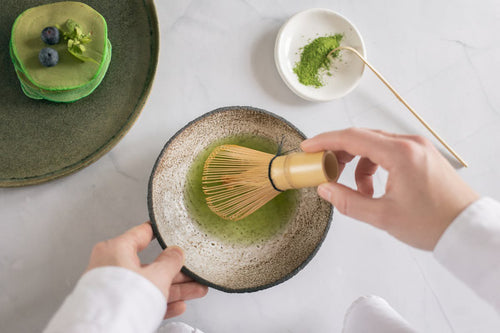Key Takeaways:
- French press coffee offers a rich, aromatic experience.
- Brewing method impacts coffee's flavor and strength.
- The ideal French press coffee-to-water ratio is 1:12.
- Grind size affects extraction: aim for a sand-like texture.
- For iced coffee, a 1:8 ratio is recommended due to dilution from ice.
- Optimal water temperature for brewing is around 195°F (90°C).
- Steeping time is crucial; typically, wait for four minutes.
- The French press method eliminates the need for paper filters.
- The Hoffman method emphasizes patience for a clearer brew.
- Experimentation is key to finding your perfect brew.
Everyone takes their coffee differently.
Adding cream and sweetener is the least of it when considering your drink’s flavour and strength. That’s because your brewing method affects how much you extract from the coffee beans, inevitably affecting your morning pick-me-up.
If you’re looking for a rich coffee experience guaranteed to wake you up with unmatched taste and exquisite aroma, consider the classic and often underrated french press coffee.
In this article - we delve into the magic french press coffee ratio that’ll give you the perfect pot of coffee every time.

What’s Unique About French Press Coffee?
What is it about the time-tested french press that makes it stand out from other coffee makers? More importantly, how do you know whether it’s right for you?
It’s not a ‘like for like’ comparison to compare French press coffee with espresso (or even the Aeropress) as the methods and flavour profiles are entirely different.
If you’re looking to compare french press coffee with other methods of its category - it’s best to do so with other pressure-free ‘immersion’ type brewing methods such as pour-over coffee (e.g. Chemex or V60) or drip coffee makers that pour hot water over coffee grounds before straining it into a cup or pot.
The drawback (in my opinion) of these particular methods over a french press is that the boiling water comparatively has limited contact with the grounds as it passes through, absorbing less flavour (i.e. not completely immersed).
The water also passes through a paper filter that absorbs the oils and can impart a ‘paper taste’. While you can double up on grounds for a more substantial taste, it’ll start costing you a fortune in coffee to do this.
A french press eliminates the use of paper filters and steeps the grounds in water for an extended period, allowing the hot water to extract all of the coffee flavour and molecules.
The French press creates some of the most flavoursome coffee brews, but there’s still a fine line between over-brewing, under-brewing, and getting the perfect cup of coffee. The strength and flavour depend on multiple factors - from the grind size, steeping time, and coffee type - and last but definitely not least - nailing the correct french press coffee ratio.

Get Your Coffee Grind Size Right
Over-extracting from coffee grounds is the most common culprit for an unusually bitter brew, no matter the method. Then again, under-extracting leaves you with a weak and watery cup. Grind size heavily affects the extraction process - and generally speaking - the finer the grounds, the richer the flavour.
The grind for your french press should be something approaching the size and texture of fine sand or salt. Rub some between your fingers to feel for a similar texture. If you find your grind produces a bland brew, readjust the coarseness setting to produce a finer grade that will release more flavour (it’s also essential to make sure you have high-quality coffee).
It’s also important to note that coffee is affected by oxygen very quickly - so only buy it in small fresh batches and don’t let it sit for too long. And whether it’s whole bean or freshly ground - always remember to store it in an airtight container as well.
Finding the Best Coffee To Water Ratio for French Press
After preparing your coffee grounds, it’s time to consider the other key ingredient: water.
The best general french press coffee ratio of grounds to water is 1:12 (e.g. 30 grams of coffee in 350 ml of water).
While this amount isn’t the magic ratio for everyone’s flavour profile and all coffee types, start here and adjust accordingly.
This will give you a great baseline to start on. If you find it’s a bit too strong - add more water (something like a 1:18 ratio is common) or alternatively, if you need a bit more kick - reduce the ratio to 1:10 and see if that gives you the flavour boost you need.
Everyone's taste is different and the flavour of coffee can be affected by many things, so, plenty of experimenting is necessary to land on your ideal coffee-to-water ratio.

The Best French Press Iced Coffee Ratio
When it comes to cold brews using a French Press, the ratio can differ from the traditional hot brew. Given that iced coffee is typically diluted with ice, starting with a stronger brew is advisable.
A common ratio for iced coffee is 1:8 (e.g. 30 grams of coffee to 240 ml of water). Once brewed, this concentrated coffee can be poured over ice, which will melt and dilute the coffee to the desired strength.
Remember, as the ice melts, it will water down the coffee, so starting with a more potent brew ensures that the final iced coffee maintains a robust flavour.
The Ideal Water Temperature for French Press Coffee
For the best French Press brew, it's recommended to use water that's heated to approximately 195°F (90°C). Instead of boiling the water and using it immediately, bring it to a boil and then allow it to sit for about a minute to reach the desired temperature. Checking with a thermometer can help in achieving the precise temperature for brewing coffee.
Key Steps to Brewing Epic French Press Coffee - Every Time
Making quality french press style coffee relies on a number of things that may appear intimidating if you’ve never done it before - but will become second nature by your 3rd or 4th cup.
Step 1 is gathering your equipment, which should include the following:
- A high-quality french press coffee maker (don’t go cheap here - it makes a big difference)
- Filtered water as regular tap water has ions and other chemicals in it that affect the taste of water
- A stovetop kettle or electric jug to boil water
- Your favourite brand of coffee beans (these are ours)
- A coffee grinder that allows you to make medium to coarse grounds
- A set of coffee scales to help you weigh your coffee grounds
- A spoon for stirring
- Your favourite coffee cup, mug, or pot
- A paper filter (optional for catching sediments so that they don’t pass into your cup)

1. Boil the Water
Whichever way you choose to boil your water, whether with a water heater, kettle, or tin billy, you’ll want to get your water temperature a bit lower than boiling - preferably landing between 90 and 96 degrees Celcius. If the water temperature surpasses this range, it can burn your coffee grinds, creating an overly bitter taste. A temperature lower than this and you may not extract enough flavour.
A typical french press makes eight cups of coffee at once. If you’re making a whole pot, boil 700 grams of water, which averages 87.5 grams per cup. Depending on your unique press coffee ratio and the amount of coffee you’re making, increase or decrease the water you boil accordingly.
2. Prepare the Coffee Grounds
This is where it's handy to have a set of coffee scales, or at least a reliable kitchen scale.
To hit the magic 1:12 coffee-to-water ratio, you’ll need 60 grams of your chosen coffee grounds for the 8-cup maker and 700 grams of water. Then, use your grinder to get your beans to a medium-coarse french press grind. Again - you’re looking for something close to a sand or sea salt texture.
You’re now ready to start brewing!
3. Mix the Hot Water and Coffee Grounds
Place the coffee grounds in the coffee maker chamber and then begin pouring the hot water over them.
Pour gently, so you don’t scorch yourself with spills or splashes. Only add about 120 grams of water to start and let the mix sit for a minute or so. This is known as the blooming process.
Now, use a wooden spoon for a gentle stir. If your french press coffee maker is glass it becomes even more sensitive with boiling water, mixing with a metal spoon may add too much pressure, cracking the glass.
After stirring, let the mixture sit for 30 seconds, add the remaining hot water, and put the lid in place - however, don't begin plunging and filtering yet.
4. Steep and Enjoy
Before you press the plunger down on your mixture to wring out the grounds and extract your brew, wait four minutes.
To prevent under or over-steeping your mix, set a timer for accuracy. Once the timer has rung, slowly and steadily press down on the plunger.
You’ll notice a light pressure as the plunger works its way through the brew and pushes the coffee grounds to the bottom of the compartment. If using finer grounds, you’ll feel more restricted movement and see small particles float back up into your brew. If your grounds are too coarse, you’ll note the opposite as the plunger will practically plunge itself to the press floor.
After straining your brew with the plunger, remove your coffee immediately. This action ensures it doesn’t over-steep from prolonged contact with the coffee grounds on the press floor.
That’s it! You’ve earned a nice cup of coffee!
What’s the Hoffman French Press Method?
While many coffee enthusiasts have their own variations of brewing with a French Press, few methods have gained as much attention as the Hoffman method.
Named after James Hoffman, a World Barista Champion and coffee scientist, this method promises a cup of coffee that's clear, rich, and devoid of bitterness.
At its core, the Hoffman method is about patience and precision. It's not your quick plunge-and-pour method. Here's a quick rundown on his French press recipe:
-
Coarse Grind: Start with coffee beans that are coarsely ground, similar to breadcrumbs. This ensures optimal extraction.
-
Water Temperature: Use water just off the boil, around 195°F (90°C).
-
Coffee-to-Water Ratio: Aim for a 1:15 coffee-to-water ratio this time. For example, for every 30 grams of coffee, use 450 grams of water.
-
Bloom: Pour a small amount of water (just enough to wet the coffee grounds) and let it sit for 30 seconds. This allows the coffee to release any trapped gases, ensuring a smoother brew.
-
Pour and Stir: Add the rest of the water and give it a gentle stir to ensure all the grounds are saturated.
-
Wait: Here's where the patience comes in. Let the coffee steep for about 4 minutes.
-
Break the Crust: After 4 minutes, you'll notice a crust of coffee grounds on the surface. Gently stir the crust, which will cause the grounds to sink to the bottom.
-
Wait Again: Allow the coffee to sit for another 5-7 minutes. This extended waiting period lets the fine particles settle at the bottom, reducing the amount of sediment in your cup.
- Plunge and Pour: Gently press down the plunger, ensuring you don't agitate the coffee too much. Pour the coffee slowly into your cup, leaving the last bit (which contains most of the sediment) in the press.
The brilliance of the Hoffman method lies in its simplicity. By allowing the coffee to sit for longer, it ensures that the fine particles (which often cause bitterness) settle at the bottom. This results in a clearer cup with a more pronounced flavour profile.
By breaking the crust and waiting again, the method also minimizes the amount of sediment in the final cup, which is a common complaint with traditional French Press brewing.
Again - the French Press requires some experimentation and there are many different opinions on what the perfect ratio is, the ideal steep time and the exact method. Here is another brewing method we love - similar to our own but with a few differences:
FAQs on French Press Coffee
1. What is the blooming process, and why is it important?
The blooming process occurs when you first mix a small amount of hot water and the coffee grounds.
As the coffee grounds come in contact with the water, they release carbon dioxide, which allows them to soak up water and create a rich flavour.
You’ll notice bubbles rushing to the surface of your brew for about 30 seconds as it ‘blooms’ or ‘degases’ after which, you can then go ahead and add the rest of your water and begin steeping.
2. Is there any leeway on the steeping time?
Many brewers will tell you to allow the mixture to sit for no more or less than four minutes. However, many factors may affect this duration, including the temperature of your water. If your water cools down or hasn’t reached the optimal boiling range before steeping, steep it for an extra minute to prevent a weaker brew.
You may even steep for six to eight minutes with coarser grinds or two to three minutes with finer grinds to ensure strong but not overwhelming coffee.
This is a personal choice of how you like your coffee and may require some experimenting on your part.
3. Does french press coffee replace an espresso machine?
No, french press coffee and espresso coffee are two entirely different styles with notable differences in flavour and method.
One does not replace the other - the one you choose comes down to your own personal coffee-drinking preferences.

Your Perfect Brew!
Every coffee drinker is different, however, if you want to make a great Fench Press coffee, using a coffee-to-water ratio of 1:12 is a great place to start experimenting with your brew.
The simple design and brewing process of the french press means it's not only a great countertop coffee maker, but easy to trave with as well (dare I say it's one of the classic road trip necessities?)
Still, it’s up to you to determine the appropriate measurements. From your water and coffee ratio to the temperature and steeping time, alter the factors until you find your perfect taste.















